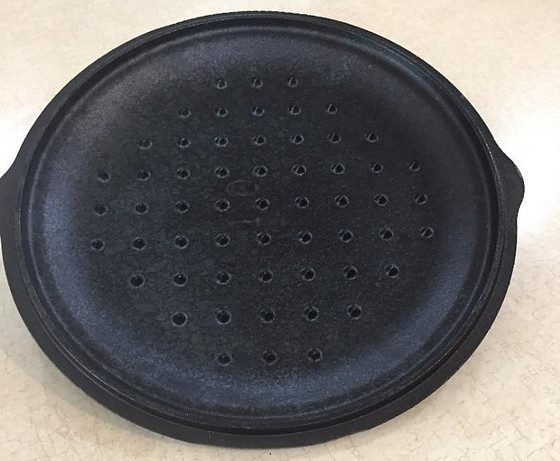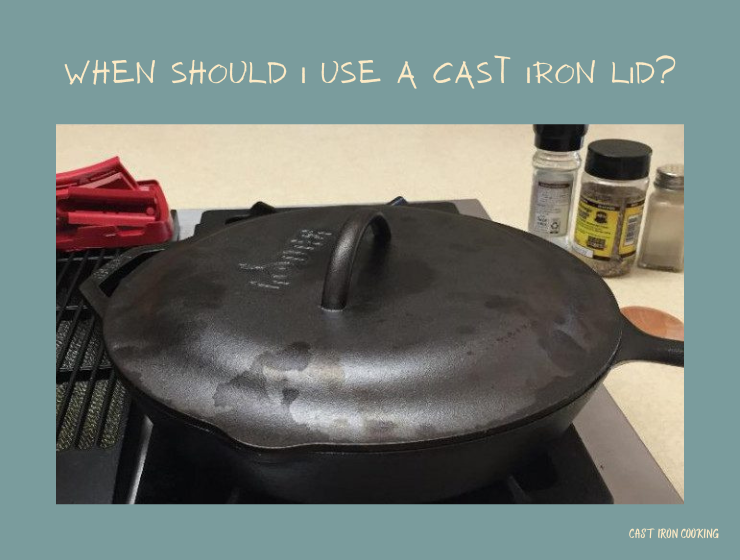Have you been cooking with cast iron and wondered, “When should I use a lid for my cast iron skillet?”
Or your asking, “Do I even need a cover, and if so, which is better, glass or cast iron?”
Maybe you feel like a lid isn’t necessary, and if a recipe calls for one, you can just improvise.
It’s true; you can find ways to get around using a lid or come up with a makeshift cover that will serve your purposes.
But in general, having a lid is a good idea.
So, let’s go over some of the times you will use one, and from there, you can decide if you need a lid for your cast iron skillet.
Table of Contents
When Should I Use a Lid For My Cast Iron Skillet?
There are at least three times when you’ll want to use a lid on your cast iron skillet. Mainly it will be when wanting to keep the heat or both the heat and moisture in the pan. Moist heat is used in several cooking methods and require a lid for all or some of the time. In addition, another time to use one is when you want to melt some cheese on top after the food is done cooking. Much of cast iron cooking doesn’t call for a lid, but having one available makes your skillet more versatile. If it’s also cast iron, it even can transform your skillet into a shallow dutch oven.
1. When You Want to Keep the Heat In
For example, you can use a lid to bring something to a simmer or boil quicker.
The wisdom of boiling water in cast iron is up for debate, with some claiming it weakens the seasoning.
I have no doubt that boiling water repeatedly or for long periods will affect the seasoning.
Nevertheless, people do boil water in their cast iron cookware.
Of course, once the water boils, remove the lid to add whatever food you are cooking, be it pasta, potatoes, or beans.
And for the most part, you will leave the lid off, so you don’t risk the water boiling over.
However, simmering is a bit different.
Again, you can put the lid on to get your liquid to the boiling point, but then you will lower the heat and remove the cover.
To prevent splattering, you can use a splatter screen, or if you’re sure the temperature is correct, you can keep the lid on.
Just make sure it doesn’t start boiling again.
But if you’re trying to thicken the liquid in the skillet, you’ll want the lid off so the moisture can escape.
RELATED > > > > > Is It Okay to Boil Water in Seasoned Cast Iron – Or Water-Based Foods?
2. When You Want to Keep in Both the Moisture and Heat
Steaming and braising are both cooking methods in which the food cooks slowly and is covered.
Rice is an excellent example because it needs both moisture and heat to cook. After the water has boiled, you add the rice, turn down the heat, and let it steam for 15-20 minutes.
It just so happens when I did it, though, my rice stuck to the bottom of the skillet and was a pain to clean.
However, if your skillet is well-seasoned (not newer like mine), you are less likely to have this problem.
Braising involves slow-cooking tougher cuts of meat such as brisket or chuck steak.
The moist heat breaks down the connective tissue, making the meat tender.
RELATED > > > > > Can I Make Rice in My Cast Iron Skillet? – 4 Easy Steps
3. When You Need It For a Few Minutes to Melt the Cheese
When the last step to finishing is adding cheese to your skillet meal or burger, that’s a great time to add a lid.
First, remove the skillet from the heat source so your food doesn’t keep cooking.
Cast Iron Lid Versus Glass

The main advantages of having a cast iron lid for your skillet are:
- The lid is self-basting
- Your skillet becomes a shallow dutch oven
- It is oven-safe
The advantages of using a glass lid are:
- You probably already have one in your kitchen that will fit
- It allows you to see inside without lifting the lid
- The lid is much lighter
Of course, if you have a dutch oven already, which comes with a cast iron lid, it might fit your skillet.
And some people have said they don’t bother with a lid, preferring to use aluminum foil or a baking sheet.
So, in the end, it comes down to preference.
When Not to Use a Lid
I don’t use a lid very often when cooking in cast iron because most of my cooking falls into the reasons not to use one.
Such as:
Searing – any type of meat or seafood
Frying – bacon and eggs, potatoes, vegetables, stovetop skillet meals
Oven skillet meals, desserts, or bread
When needing the liquid to evaporate
When wanting the sauce to thicken
Cast Iron Q & A: Put a Lid On It
A Few Practical Uses for a Lid
- Melting cheese on burgers or skillet meals made on the stovetop
- Cooking over-easy eggs without flipping
- Slow cooking meat
- Camping to keep out debris and holds in heat
- Making rice or skillet potatoes
- Reheating food
- Stewing vegetables
- Keeping food warm longer
- For grilled cheese, use a lid partially off to let moisture escape, but keep the heat in (this is when I improvise and use a small baking sheet that partially covers the top of the skillet)
Hashbrown Skillet with Pork
This meal calls for a lid at the end for melting the cheese. But before that, you are frying and thickening, so you wouldn’t want to use one.

Ingredients
- 4 cups frozen O’Brien Potatoes (I diced real potatoes)
- 1 cup onion, chopped
- 1 cup green pepper, chopped (I didn’t have any)
- 1 cup red pepper, chopped (I didn’t have any)
- 2 Tbsp. butter
- 2 cups shredded or chopped cooked pork (I used leftover pork chops)
- 2 tsp. chicken bouillon
- 1/4 tsp. pepper
- 2 tsp. flour
- 1/2 cup milk
- 3/4 cup shredded cheddar cheese
Directions
- In a 12-inch cast iron skillet, cook onion and both peppers in butter over medium heat until almost tender
- Stir in pork, bouillon, and pepper – heat through
- In a small bowl, combine flour and milk until smooth – add to skillet
- Cook over medium heat until mixture is thickened, about 4-5 minutes – stir frequently
- Sprinkle with cheese, remove from heat, cover, and let sit until cheese is melted
Tip
Have all your ingredients ready before you start cooking because it moves pretty fast.
Final Thoughts
As you can see, using a lid on a cast iron skillet is pretty much the same as using one on any type of cookware.
So, if you were wondering, “When should I use a lid for my cast iron skillet?” hopefully, you now understand when and when not to use one.
Use a lid whenever you want to keep the heat or both the heat and moisture in the skillet.
Or to melt cheese on your food after it’s done cooking.
Although you can probably get by without a lid, having one gives you more cooking options.
What do you think?
Do you use a lid when cooking in your cast iron skillet?
If so, in what ways?
Let me know in the comments below.

